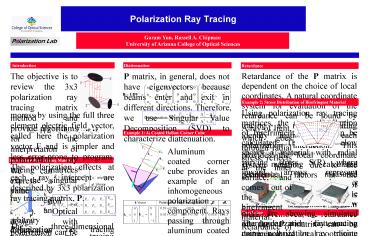Polarization Ray Tracing PowerPoint PPT Presentation
1 / 1
Title: Polarization Ray Tracing
1
Polarization Ray Tracing
Garam Yun, Russell A. Chipman University of
Arizona College of Optical Sciences
Introduction
Diattenuation
Retardance
The objective is to review the 3x3 polarization
ray tracing matrix method and provide algorithms
for the interpretation of polarization ray
tracing matrices via the singular value
decomposition (SVD). Optical design with
polarization can be systemized by generalizing
Jones matrices into a 3 x 3 matrix formalism to
handle arbitrary propagation directions. The
polarization ray tracing calculus avoids the
local coordinate
P matrix, in general, does not have eigenvectors
because beams enter and exit in different
directions. Therefore, we use Singular Value
Decomposition (SVD) to characterize diattenuation.
Retardance of the P matrix is dependent on the
choice of local coordinates. A natural coordinate
system for evaluation of the retardance can be
found by tracing a ray, substituting identity
matrices for each polarization interaction. This
provides the local coordinate system rotation due
to the geometrical factors in the system. The
Eigen-analysis of the P matrix, with this
geometrical coordinate system rotation removed,
the retardance of the P matrix can be determined.
Example 2 Stress Distribution of Birefringent
Material
Using polarization ray tracing matrices, the
stress distribution of birefringent material can
be calculated. The figure below shows a material
with radial varying stress S(R) where inward
arrows represent compression and outward arrows
represent tension.
morass by using the full three element electric
field vector, called here the polarization vector
E and is simpler and less error-prone to program.
The polarization effects at each ray intercept
are described by 3x3 polarization ray tracing
matrix, P. Polarization ray tracing matrix
forms have been developed to describe Fresnel
equations as well as thin films, polarizers,
retarders, diffraction gratings, and many other
optical elements. The 3 x 3 matrix formalism is
used to analyze polarization properties of an
example corner cube and birefringent material.
A ray of light, which goes through radial stress,
reflects at the inner surface, and comes out of
the birefringent material. Retardance of this ray
is given below
Example 1 Al Coated Hollow Corner Cube
Aluminum coated corner cube provides an example
of an inhomogeneous polarization component. Rays
passing through aluminum coated hollow corner
cubes encounter three reflections. As a ray
propagates, s and p polarization states are
different at each surface. For aluminum coated
hollow corner cube filled with air following
table shows polarization ray tracing matrix,
propagating vector and diattenuation for hollow
corner cube.
Polarization Ray Tracing Matrix, P
By matching calculated retardance to measured
retardance we can find the stress distribution
inside the birefringent material. Below plots are
showing simulated retardance and diattenuation
using polarization ray tracing matrices for the
material.
We can express a plane wave propagating in an
arbitrary direction as the polarization vector ,
a 3x1 complex vector,
Conclusion
The polarization ray tracing matrices avoid local
coordinate morass and simplify the problem. They
are also useful for ray tracing software since it
is easy to convert results into the other vectors
and matrices.
The three-dimensional polarization ray tracing
matrix, P characterizes an optical element or ray
path.

